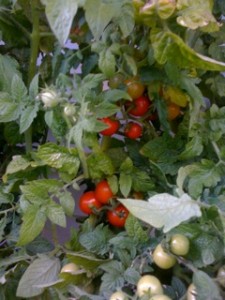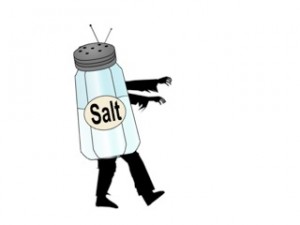
“The only things that money can’t buy are love and home-grown tomatoes.”
I heard this in a song last week and I believe it to be true.
There is nothing like the taste of home-grown tomatoes. The tomatoes we get in the stores are mere thick-skinned, tasteless, mealy, red orbs, even when we pay $4 per pound for the privilege of buying them “on the vine”. They’re designed to look pretty in the supermarket, all the same size and shape, and thick-skinned to survive travelling the globe.
Many Calgary gardeners picked bushels of green tomatoes off their plants prior to the first snow of the season, the summer season! We got several inches from September 8 to 11,

devastating our city’s mature deciduous trees.
I simply covered my tomatoes and prayed. They were late starting and had just begun looking promising after six weeks of decent summer weather. I thought we’d get a skiff of snow, some frost and then I’d uncover them and they would flourish in our two additional months of summer. Dreamer!
Almost a week later I have yet to uncover them. The snow was followed by several nights of serious frost. I’m frankly, scared to look.
For those who picked them all, here are some tips for getting the most out of your home-grown tomatoes.
- Sort them. I put them one layer deep, not touching each other, in stackable boxes in a cool dark place. I tend to put the larger tomatoes together and the cherries, grapes and other minis together.
- Check often. Tomatoes can ripen overnight, it seems. One day there are none. The next, there are too many to reasonably consume.
- Eat them. In tomato season, I serve sliced tomatoes at almost every meal. They provide enzymes, vitamin C, lycopene, and taste so wonderful! A fabulous dish is tomato soup (see recipe) made with home-grown tomatoes. You’ll never go back to the canned stuff.
- Freeze them. When the ripening tomatoes exceed our ability to consume them, I wash and dry the excess, pop them whole into freezer bags and freeze. Then when I need canned tomatoes for a soup, stew, or other dish, I simply run the frozen tomatoes under hot water. The skins peel right off and I throw the tomatoes into the pot, chopped or not. As canned tomatoes are quite salty, I usually add salt to the dish. Freezing is so much easier than canning tomatoes, less labour, heat, and electricity. I can use just one tomato or a number. (When I open a can, I have to use them all!) I rarely buy canned tomatoes: even the organic ones come in plastic lined tins, a source of toxins.
- Share them! Non-gardeners have no idea how wonderful home-grown tomatoes taste. If you share this “candy*” with them, you might motivate them grow their own tomatoes.

It seems to me there would be more of the other thing money can’t buy, love, if more people knew the joy of home-grown tomatoes.
*That’s what my friend called them to get her reluctant Grandtoy to try her home-grown tomatoes. Grandtoy agreed and ate more!

